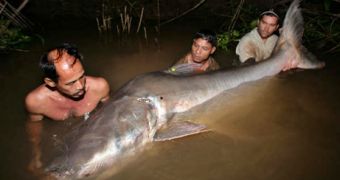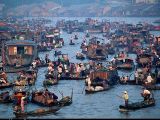The largest river in Southeastern Asia, Mekong is also the 11th-longest river in the world and the 12th-largest in volume (discharging 475 km? of water annually). Its estimated length is 4,880 km (3,032 mi), and it drains an area of 810,000 km? (313,000 sq mi). From the Tibetan Plateau it runs through Yunnan (China), Burma, Thailand, Laos, Cambodia and Vietnam. The name Mekong comes from Thai "Mae Nam Khong", "Mother of all rivers". In China (covered by half of the river's length), Mekong is called Lacang. From the river's springs to the exit of China it has a level difference of 4,500 m (15,000 ft)!
Mekong makes the border between Myanmar and Laos and between Laos and Thailand. In Cambodia it splits in two, forming a large delta in the southern Vietnam, with a surface of 40,000 square km (the size of Netherlands) and a total channel length of 3,200 km (2,000 mi), which flows into the South China Sea. The capital of Laos, Vientiane, and that of Cambodia, Phnom Penh, are both located on Mekong.
Towards the end of the 1860, the French attempted to find a navigable way upward Mekong towards China but their plans were shattered when near the city of Kratie (Cambodia) they found rapids and in southern Laos a succession of waterfalls called Khone Falls. The debit of these cascades is the largest of all waterfalls in the world, being twice the debit of Niagara.
The river sustains the life of about 100 million people belonging to about 100 ethnic groups. Annually 1.3 million tons of fish are captured from this river, four times the quantity fished in the North Sea! There are about 1,200 fish species in Mekong, about 7 times more than in all rivers of Europe. The Mekong giant catfish can reach 3 m (10 ft) in length and be 350 kg (780 pounds) heavy, being considered world's largest river fish. Today, the species is menaced with extinction. The Cambodia's currency, riel, is called after a Mekong small fish, Cirrhinus caudimaculatus. Locals grow shrimps on Mekong.
Another menaced giant in the Mekong river is the Irrawaddy dolphin (Orcaella brevirostris) that does not overcome 100 individuals now in the lower Mekong.
The sediment rich waters allow one of the highest rice productions in the Mekong's delta, three harvests per year, which makes Vietnam world's second largest rice exporter after Thailand. For the locals, Mekong is a navigation way. Tourists can visit the Khone Falls but they can also go on the river upward till Loungphrabang, once the capital of Laos, which still bears a colonial atmosphere.
Today, Mekong faces many environmental issues like overfishing (especially with destructive methods), deforestation, and dam constructions. Some catfishes migrate between Mekong and the sea for breeding or feeding and dams interrupt these cycles.

 14 DAY TRIAL //
14 DAY TRIAL // 
